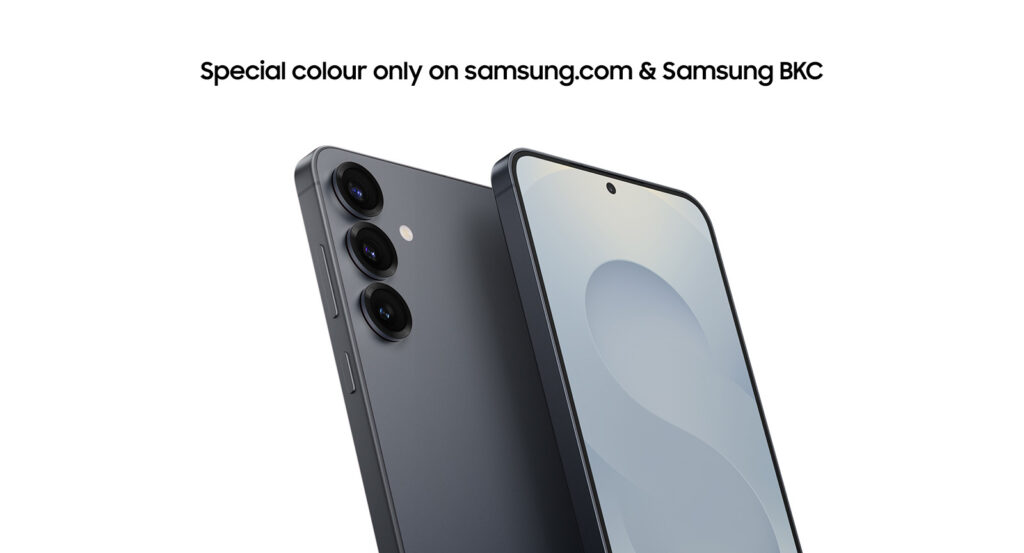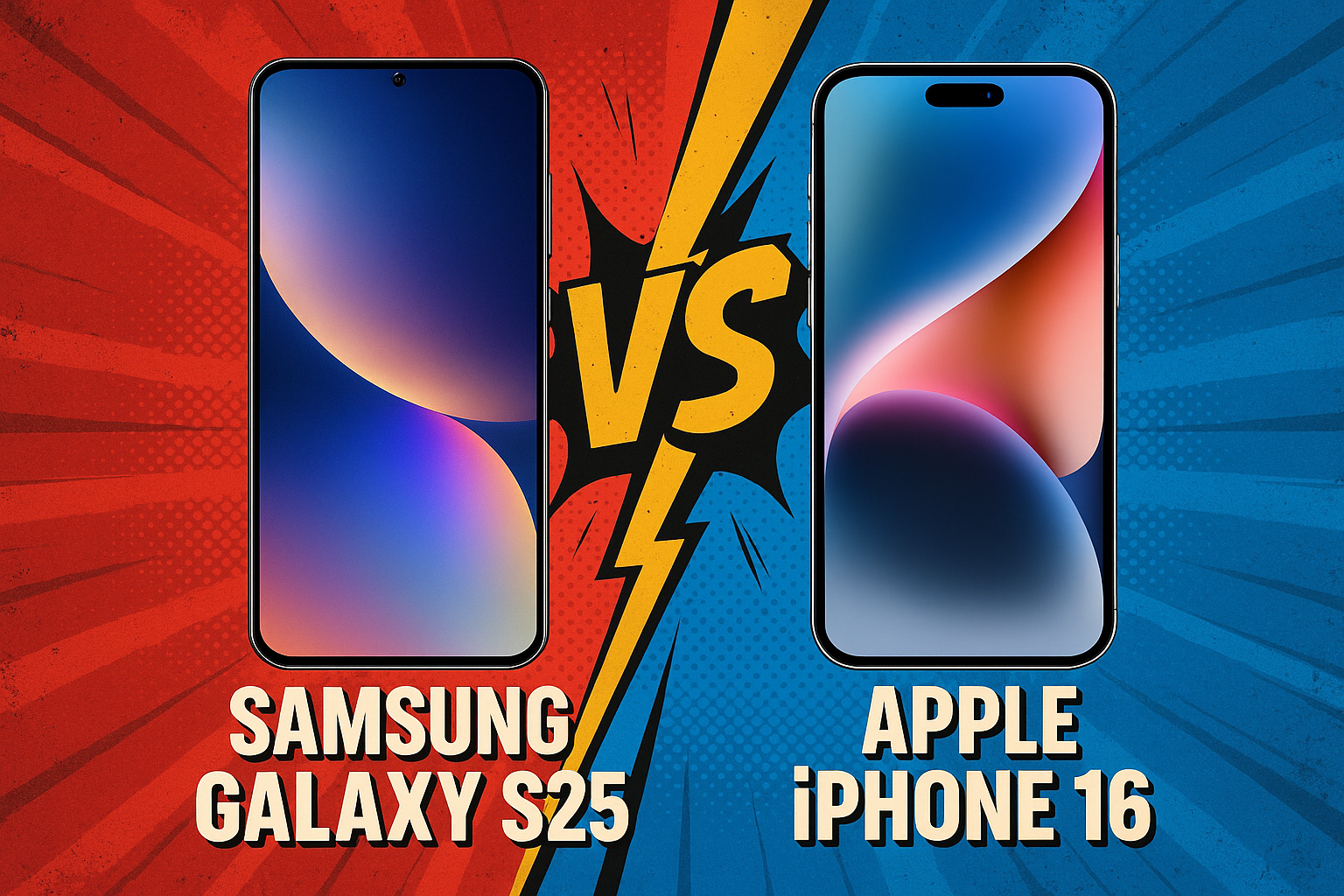Galaxy S25 Vs iPhone 16: Battle of Supremacy, Secret Insights Inside!
In 2025, Two tech giants Apple & Samsung flagship smartphones are no longer just about raw specs—they’re battlegrounds for AI integration, user-centric software, and ecosystem in depth.
We compare Samsung’s Galaxy S25 series (powered by the Snapdragon 8 Elite for Galaxy with seven years of support) against Apple’s iPhone 16 lineup (driven by the A18/A18 Pro and Apple Intelligence). From design to camera, battery to AI features, this head-to-head will help you choose your next daily driver.
Head-to-Head Comparison: Counterpart Models
This section provides a direct comparison of the most closely aligned models from the Samsung Galaxy S25 and Apple iPhone 16 series, highlighting their respective strengths and weaknesses.
Also Read: Galaxy S25+ Vs iPhone 16 Plus: Fight of Two Heavyweights
Samsung Galaxy S25 vs. Apple iPhone 16
| Feature | Samsung Galaxy S25 | Apple iPhone 16 |
| Display Size | 6.2-inch Dynamic AMOLED 2X | 6.1-inch Super Retina XDR OLED |
| Display Resolution | 2340×1080 (FHD+) | 2556×1179 |
| Max Refresh Rate | 120Hz Adaptive (1-120Hz) | 60Hz Fixed |
| Peak Brightness | 2600 nits | 2000 nits |
| Processor | Qualcomm Snapdragon 8 Elite for Galaxy | Apple A18 |
| RAM | 8GB (some markets 12GB) | 8GB |
| Base Storage | 128GB (UFS 3.1) | 128GB |
| Battery Capacity | 4000 mAh | 3561 mAh |
| Wired Charging | 25W | ~25W MagSafe, ~1h 40m to 100% |
| Rear Camera | 50MP Wide, 10MP Telephoto (3x), 12MP Ultrawide | 48MP Fusion (2x Telephoto), 12MP Ultrawide |
| Front Camera | 12MP | 12MP TrueDepth |
| OS | Android 15 (One UI 7) | iOS 18 |
| Software Support | 7 years OS & Security | Typically 5-6 years OS, longer security [Implied from Apple’s history, not explicitly stated for 16 series] |
| Starting Price (US) | $799.99 USD (₹74999.00 INR) | $799 USD (₹79900.00 INR) |
Also Read: Ultimate Comparison of Samsung Galaxy S25 Series: Explore Powerful Insights

Heart of the Beast: Snapdragon Vs A-Series
- Galaxy S25
- Snapdragon 8 Elite for Galaxy (Built on 3 nm TSMC)
- Octa-core up to 4.47 GHz, 8 GB RAM (UFS 3.1 on 128 GB)
- Vapor chamber 15% larger for sustained performance
- iPhone 16
- A18 6-core CPU + 16-core Neural Engine
- 8 GB RAM
- Optimized for efficiency with iOS 18
Did you Know? In benchmarks, the S25 scores of 2.18 million AnTuTu score beats the iPhone’s 1.76 million—great for multi-core and GPU tasks. But Apple’s single-core speed (Geekbench 3,278) still leads, translating to silky real-world snappiness in apps and games.

Camera Showdown: Generative AI vs. Fusion Optics
- Galaxy S25
- 50 MP wide (f/1.8, OIS), 10 MP tele (3×), 12 MP ultrawide
- “Next Gen ProVisual Engine” with Generative Edit, Audio Eraser
- LOG video capture & AI ProScaler
- iPhone 16
- 48 MP Fusion main (f/1.6, sensor-shift OIS + 2×), 12 MP ultrawide
- Physical Camera Control button & Visual Intelligence
- Spatial photos/video + Clean Up tool
Pro Tip: Want to remove photobombers seamlessly? Galaxy’s Generative Edit feels like magic. Prefer a tactile shutter dial and spatial capture? iPhone’s Camera Control button and Vision-Pro-ready images deliver.
AI & Software: One UI 7 vs. iOS 18 + Apple Intelligence
- Samsung One UI 7 (Android 15)
- AI-first Now Bar & Now Brief
- Seven years of OS/security updates
- Deep generative imaging and Galaxy AI suite
- iOS 18 + Apple Intelligence
- On-device AI for privacy; Writing Tools & Live Objects
- Natural-language photo/video search
- Five years of updates (2025–2030)
Love AI?: Crave cloud-augmented, cross-app AI? Samsung’s generative features shine. Love on-device inference with privacy guarantees? Apple’s local Neural Engine is your ally. Both ecosystems now speak “AI,” but your privacy vs. versatility preference decides the winner.
Connectivity & Extras
- Galaxy S25: 5G (sub-6 + mmWave), Wi-Fi 7, Bluetooth 5.4, NFC, Dual-SIM + eSIM, IP68.
- iPhone 16: 5G (sub-6 + mmWave US), Wi-Fi 7, Bluetooth 5.3, NFC, eSIM-only US, IP68, UWB 2nd gen, Satellite SOS.
Quick Insight: If you need physical SIM flexibility, Samsung. If satellite emergency features and UWB spatial precision speak to you, Apple.
Pros of Samsung Galaxy S25:
- Superior Display: Offers a higher 120Hz adaptive refresh rate
- 2600 nits peak brightness
- More Versatile Camera Hardware: A dedicated 10MP 3x optical telephoto lens, offering true optical zoom capabilities
- Better Gaming Performance (Benchmarks): Leads in AnTuTU multi-score but still lags behind Apple’s A-18 chip in Geekbench’s single-score.
- Longer Software Support Commitment: 7-year commitment for OS and security updates offers
- Advanced Generative AI: Galaxy AI’s Generative Edit (Magic Eraser) is often more effective at complex object removal.
- Greater Customization: One UI 7 based on Android 15, with features like Good Lock, offers extensive personalization options for the home screen and UI.
Cons of Samsung Galaxy S25:
- Slower Base Storage: The 128GB model uses older UFS 3.1 storage
- Slower than UFS 4.0 found in higher capacities and some competitors
- Slower Charging Speed: 25W wired charging is considered slow for a 2025 flagship
- Hybrid AI Model: Cloud-based processing for some advanced AI features raises privacy concerns for some users.
- Perception of Incrementalism: Some users feel it’s not a significant enough upgrade from the S24 to warrant a new purchase.
Pros of Apple iPhone 16:
- Optimized Performance: Apple’s A18 chip offers strong single-core CPU performance
- Privacy-Centric AI: Apple Intelligence’s on-device processing, keeping sensitive data local for enhanced privacy and security.
- Robust Ecosystem Integration: Seamless connectivity and feature sharing with other Apple devices (Mac, iPad, Watch) provide a cohesive user experience.
- Highly Polished Software: iOS 18 offers a clean, intuitive, and generally bug-free user interface, with new customization options.
- New Camera Control Button: Provides a tactile and intuitive way to interact with the camera
- Strong Brand Resale Value: iPhones typically retain their value well in the secondary market.
Cons of Apple iPhone 16:
- 60Hz Display: The fixed 60Hz refresh rate is a significant drawback for a flagship phone in 2025
- Less Advanced Generative AI: Apple Intelligence’s Clean Up tool is often less effective for complex object removal than Samsung’s generative AI.
- No Dedicated Telephoto Lens: Relies on digital zoom or cropping from the main sensor for telephoto shots, which may result in lower quality compared to optical zoom.
- Less Customization: Offers less flexibility than Android’s One UI for deep personalization
- Slower Charging Speeds: Wired charging times are longer compared to many Android flagships.
Also Read: Shocking Truth: Samsung Galaxy S25 Series Phones Tested – How Long Do Their Batteries LAST?
Verdict: Your 2025 Flagship Choice
- Choose Galaxy S25 if…
- You want high-brightness, 120 Hz smoothness
- You love AI-driven photo/video editing
- You prioritize long-term updates and thermal performance
- Choose iPhone 16 if…
- You value ecosystem integration and on-device AI
- You prefer best-in-class single-core speed
- You appreciate tactile camera controls and spatial capture
Both flagships push boundaries in 2025. Ultimately, decide by which strengths—display fluidity, AI power, or ecosystem polish—matter most to you.

